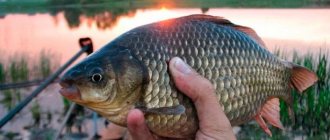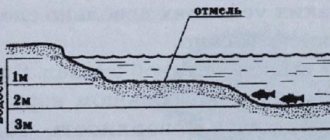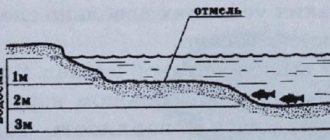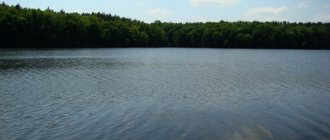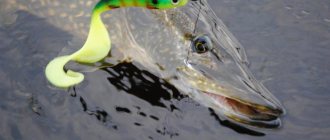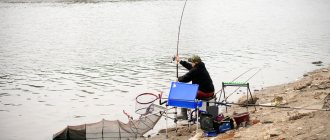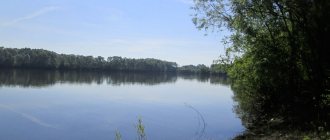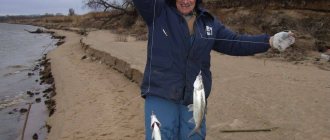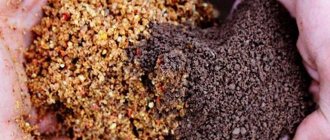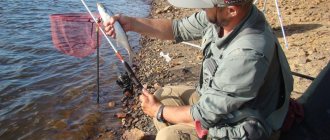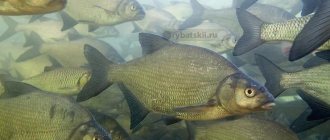Where to look for bream
Catching bream on a feeder in the spring is complicated by the fact that it is absent from the usual summer stops; it will return there soon after spawning at the end of April or May, the timing is different for the southern, northern regions or the middle zone.
In April, he scours the entire water area, looking for food and gathering in flocks before spawning.
Most often, schools of bream ply at depths of five to ten meters, approaching the shore, where, if there are steps and edges, they can be easily reached not only with a long-range feeder, but also with a light picker. It should be taken into account that the fish practically does not linger on the vast, flat table.
The approach of bream schools to the shore in early spring is widely used by fishermen living near large rivers, for example, the Volga. In summer there is practically no place to fish from the shore; you have to fish from a boat, including the popular “ring”.
Based on the above, we can conclude: before you start catching bream, you need to examine the fishing spot using one of the well-known methods:
- jig tapping;
- dragging the load;
- casting with control of lowering the load.
Attention! It will not be possible to measure the depth of a fishing point along the river flow with a marker weight. The water flow, demolishing the equipment, will distort the real picture of the measurements.
The bream is covered with pimples. This means that its spawning has begun and it is undesirable to fish.
The approach of bream schools to the shallows is also explained by the fact that the fish is looking for future spawning grounds and tries to stay close to the chosen location. A fisherman who knows the spawning areas will always have an advantage over his fellow competitors.
Where to catch bream on a feeder in April
His favorite places are silted, clay bottom, deep parts of the reservoir. It is easy to find by observing the surface of the river a little in calm weather. The flock can be seen playing. So, you can start fishing. The easiest way to catch it is to fish at night, close to where the fish live. Usually it does not travel long distances from its permanent location.
If you have a steep yar in mind, next to which there is a calm current and quite deep, as well as a flooded tree, you need to try it. An exit from holes, a deep fairway, next to a dam or dams, a little trash - all this attracts him.
Tackle
As mentioned above, especially long-range fishing rods may not be useful. However, everything is selected for the conditions of a particular river, including the length and power of the feeder pole.
Fishing rod
Depending on the fishing distance and the strength of the current, a feeder rod is selected. The principle of reasonable sufficiency applies. The form should easily deliver a feeder of a certain weight to the required distance. At the same time, the reserve in power and length should be very small.
In slow currents, light short feeders or even pickers are used, used for fishing on a lake or large pond. The power of forms for such locations is in the range of 50-80 grams.
Medium flow involves the use of medium feeders - medium in length: 330-360 centimeters and dough 60-100 grams.
Heavy feeders are needed to work with feeders exceeding one hundred grams, while to achieve long distances, sticks 13-14 feet long (390-420 centimeters) are used.
An extra-heavy feeder is used in very strong currents with feeders from 120 grams.
Reels
For feeder fishing, large reels are used, according to the Shimano classification - from 4000 and above. Most often, feeders choose models with rear friction, but some are happy to work with front friction, it all depends on the personal habits of the angler.
Important! When choosing a size, the rule of balancing gear applies: it is absurd to put a six-thousander reel on a light picker, and a meat grinder with a 4000-unit spool on a heavy feeder.
The reel and rod should be well balanced, this will add convenience when fishing and less tire the angler’s hands.
Lines and leashes
The most important condition for successful bream fishing in April is the selection of equipment: main fishing line and leash. The best choice for the working section would be a combination of thin braid and thick monofilament as a shock leader.
Thin braid, up to 0.14 millimeters, will not only allow you to cast farther, but will also float less underwater. This reduces the load on the tackle from the action of the current, which will lead to a decrease in the weight of the feeder.
A monofilament shock leader, from 0.22 to 0.30 millimeters, will allow you to throw a heavy feeder without worrying about its possible shooting. The thickness of the leader is selected depending on the weight of the feeder with bait. The length is usually slightly less than two rods.
Attention! We recommend making the length of the leader such that the knot connecting it to the main braid, when casting, is located in front of the reel spool, but does not interfere with it.
The leash for the wary spring bream is also selected with special care. It is made from 70 to 120 centimeters long from monofilament with a diameter of 0.12-0.14 millimeters or fluorocarbon with a diameter of 0.15-0.18 millimeters.
When fishing, you need to take a supply of leashes of various lengths and diameters in order to vary the equipment during the fishing process. The secret is this:
- If there are no bites or the bite is sluggish, use the thinnest and longest leash.
- If the fish is actively biting, you can not stand on ceremony and increase the leash.
- If the fish eats the bait on the hook and no bite is visible, the leash should be shortened.
It is convenient to transport and store leashes in a special leash holder.
Snaps
In feeder fishing, several types of rigs are used; which one to use in the spring is decided by the angler himself. Many consider an asymmetrical loop to be the most successful option for the current, but you can also fish with simpler Paternosters or Gardner loops (these are, by the way, different equipment).
Some anglers are accustomed to fishing with an anti-twist tube and, despite the apparent bulkiness of the gear, show excellent results.
Attention! The safest feeder equipment for fish is considered to be inline installation. Only it is allowed to be used in fishing competitions.
Feeders
For fishing in the current, it is very important that the feeder immediately lies on the bottom and stays there, without jumping along the bottom, scaring off the fish. For this purpose, models that are optimal in weight and shape are used. The best ones:
- square;
- triangular;
- rectangular flat.
It is also important how the lead plate is attached to the metal mesh. The best way to hold the tackle in the current are those whose lead width practically coincides with the bottom area.
This type of feeder is optimal for currents - lead fills the entire plane in contact with the bottom.
Some fishermen additionally equip feeders with metal antennae, thus increasing the surface area of contact with the bottom.
Catching bream in April on a feeder
The long-awaited time of ice melting and warming opens up new horizons for fishermen. So, fishing for bream in April on a feeder is very effective, because all the fish are moving away from winter torpor and active fish biting begins in preparation for the upcoming spawning.
Bream is a bottom-dwelling fish that feeds mainly on larvae, that is, most of its food is of animal origin. With a good food supply, bream grows quickly. Found in most rivers, such as the Don and Volga; in lakes, artificial ponds with running water (Tsimlyansk Reservoir). It feeds at dawn and at night in the shallows, near the shore.
Lures
Bream, hungry over the winter, prefers high-calorie protein foods in the spring. Therefore, plant baits are practically not used in April. Fishermen mainly use:
- bloodworm;
- maggot;
- burdock moth larva;
- caddisfly;
- jig;
- dung worm;
- a combination of the listed baits - a sandwich.
A sandwich of worms and maggots will attract even passive bream.
Lure
In the spring, the same baits work as in the summer, the difference lies in the use of attractants. Now, in still unheated water, spicy and meat aromas work better:
- anise;
- garlic;
- dill;
- bloodworm;
- maggot;
- squid.
Salapinskaya porridge
How to prepare porridge for bream in a feeder
In terms of mechanical composition, Salapin porridge is good. It includes:
- pearl barley – 1 part;
- millet – 2 parts;
- corn grits - 2 parts;
- barley groats – 2 parts.
Cook the porridge in the following order:
- First they throw in the pearl barley.
- When it is almost ready, add millet, add the selected flavoring, and add sunflower oil.
- When the millet is ready, remove the porridge from the heat and add dry corn and barley grits.
- Everything is mixed and left to brew.
Appearance of classic Salapin porridge. The combination of boiled and steamed cereals is an ideal option for bream.
A simple bait option
Similar to “salapinka” is a mixture of store-bought bait with home-cooked porridge. Moreover, this may not be a special preparation, but the remains of your own dinner. In addition to cereals, you can use various pasta products.
Dry mix
Those who don’t want to bother with cereals can try this bait option, tested in many reservoirs:
- breadcrumbs (3 parts);
- shortbread cookies (1 part);
- wheat bran (1 part);
- ground corn, boiled (1 part);
- oatmeal or oatmeal (0.3 parts);
- roasted and crushed sunflower seeds (1 part);
- a little dry milk or condensed milk diluted with water for turbidity.
Fishing tactics
In terms of tactics, spring bream fishing differs little from fishing for our hero at other times of the year. Conventionally, the whole process can be divided into several stages:
- Preliminary selection of a river section for proposed fishing.
- Workplace equipment.
- Sounding depths, searching for promising points.
- Pre-feeding of selected areas. It is advisable to feed two or three points at different distances from the shore.
- The actual fishing.
To avoid problems when fishing for large bream, you should be careful about having a voluminous landing net with a long handle.
Roach fishing conditions and season
There is probably no more fun and rewarding fishing than catching roach on a spring river. Somewhere from mid-April to the first days of May, depending on the weather, the spring run of roach begins. During this period, it is caught using bottom gear, even with the most primitive baits, but roach takes it much better on the feeder.
And this is understandable: the leash with the hook and bait is in the stream of washed-out bait. And no matter how much the fish is in a hurry to get to the spawning grounds, when they come across grains of aromatic bait, and then a brush of dung worms, how can they resist? Grab it!.. And at that moment the fisherman on the shore begins to nod and twitch the quivertip of the feeder, and the bell on the rod rattles. It's time to hook! And there a red-eyed fish is already splashing in the fast stream, splashing silver splashes on the sides and bending the feeder rod. The spring roach can be especially large and strong. If we talk about the Volga, then it is the Volga soroga that rises along small rivers to the upper reaches, weighing up to a kilogram or more.
Everything would be fine, and spring time is the most fertile time without mosquitoes and midges, and the spring weather excites the soul and warms the blood, and fishing can be exciting and rewarding, but, as always, there is a “but”... The course of the roach is different for each specific chosen place happens short-term. And it’s not always possible to get exactly two or three days of the spring movement. True, if the weather is unstable, with clear days changing to gray and rainy ones, then sometimes the roach’s course is delayed. She walks and then stops, waiting out the bad weather.
Where to catch roach? It has been noticed that the “fish path” runs in the river in places where the current is a little weaker. This is understandable: the fish needs to conserve its strength, because the path to the upper reaches of the river is still long. Also, the roach tries to choose a route along some underwater hollows and along the edge of a flooded willow forest, even if it is located next to the newly formed shore. Often it is along this edge that the slope to depth is located. Such places can be very successful for feeder fishing.
The roach becomes more active, and its movement becomes massive when the water temperature is at least 10-15 degrees. And the fish bite also increases when the water gets warmer. Therefore, on cold days, often with snow, the fish just stands there, does not rise upstream and refuses any bait or bait.
Advice from experienced people
Towards the end of our conversation about spring bream fishing, here are tips collected online from experienced bream anglers:
- When fishing, you should definitely experiment with baits, combining them.
- If the bite is sluggish, you should move to another feeding point.
- You should work variably with leashes, changing their length and diameter.
- If your feeder gets torn from its place, try raising the rod, positioning it at an angle of 45-60 degrees to the horizontal. This will reduce water resistance by reducing the amount of fishing line under water.
- When choosing a quivert type, use the rule of reasonable sufficiency. Set the one that will be the most sensitive, but not react to the changing current.
